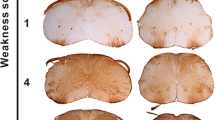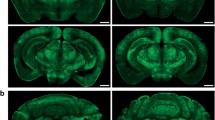Abstract
There are several diseases for which gene transfer therapy to the cerebellum might be practicable. In these studies, we used recombinant Tag-deleted SV40-derived vectors (rSV40s) to study gene delivery targeting the cerebellum. These vectors transduce neurons and microglia very effectively in vitro and in vivo, and so we tested them to evaluate gene transfer to the cerebellum in vivo. Using a rSV40 vector carrying human immunodeficiency virus (HIV)-Nef with a C-terminal FLAG epitope, we characterized the distribution, duration, and cell types transduced. Rats received test and control vectors by stereotaxic injection into the cerebellum. Transgene expression was assessed 1, 2, and 4 weeks later by immunostaining of serial brain sections. FLAG epitope-expressing cells were seen, at all times after vector administration, principally detected in the Purkinje cells of the cerebellum, identified as immunopositive for calbindin. Occasional microglial cells were tranduced; transgene expression was not detected in astrocytes or oligodendrocytes. No inflammatory or other reaction was detected at any time. Thus, SV40-derived vectors can deliver effective, safe, and durable transgene expression to the cerebellum.






Similar content being viewed by others
References
Ito M. Historical review of the significance of the cerebellum and the role of Purkinje cells in motor learning. Ann NY Acad Sci. 2002;978:273–88.
Manto M, Marmolino D. Cerebellar ataxias. Curr Opin Neurol. 2009;22:419–29.
Koeppen AH. The hereditary ataxias. J Neuropathol Exp Neurol. 1998;57:531–43.
Underwood BR, Rubinsztein DC. Spinocerebellar ataxias caused by polyglutamine expansions: a review of therapeutic strategies. Cerebellum. 2008;7:215–21.
Strayer DS, Pomerantz RJ, Yu M, Rosenzweig M, Bouhamdan M, Yurasov S, et al. Efficient gene transfer to hematopoietic progenitor cells using SV40-derived vectors. Gene Ther. 2000;7:886–95.
Strayer DS. SV40 as an effective gene transfer vector in vivo. J Biol Chem. 1996;271:24741–6.
Strayer DS, Kondo R, Milano J, Duan LX. Use of SV40-based vectors to transduce foreign genes to normal human peripheral blood mononuclear cells. Gene Ther. 1997;4:219–25.
Cordelier P, Calarota SA, Pomerantz RJ, Xiaoshan J, Strayer DS. Inhibition of HIV-1 in the central nervous system by IFN-alpha2 delivered by an SV40 vector. J Interferon Cytokine Res. 2003;23:477–88.
Cordelier P, Van Bockstaele E, Calarota SA, Strayer DS. Inhibiting AIDS in the central nervous system: gene delivery to protect neurons from HIV. Mol Ther. 2003;7:801–10.
Cordelier P, Strayer DS. Using gene delivery to protect HIV-susceptible CNS cells: inhibiting HIV replication in microglia. Virus Res. 2006;118:87–97.
Louboutin JP, Reyes BAS, Agrawal L, van Bockstaele EJ, Strayer DS. Strategies for CNS-directed gene delivery: in vivo gene transfer to the brain using SV40-derived vectors. Gene Ther. 2007;14:939–49.
Agrawal L, Louboutin JP, Reyes BAS, van Bockstaele EJ, Strayer DS. Antioxidant enzyme gene delivery to protect from HIV-1 gp120-induced neuronal apoptosis. Gene Ther. 2006;13:1645–56.
Agrawal L, Louboutin JP, Strayer DS. Preventing HIV-1 Tat-induced neuronal apoptosis using antioxidant enzymes: mechanistic and therapeutic implications. Virology. 2007;363:462–72.
Louboutin JP, Agrawal L, Reyes BAS, van Bockstaele EJ, Strayer DS. Protecting neurons from HIV-1 gp120-induced oxidant stress using both localized intracerebral and generalized intraventricular administration of antioxidant enzymes delivered by SV40-derived vectors. Gene Ther. 2007;14:1650–61.
Louboutin JP, Agrawal L, Reyes BAS, van Bockstaele EJ, Strayer DS. HIV-1 gp120 neurotoxicity proximally and at a distance from the point of exposure: protection by rSV40 delivery of antioxidant enzyme. Neurobiol Dis. 2009;34:462–76.
Strayer DS. Gene therapy using SV40-derived vectors: what does the future hold? J Cell Physiol. 1999;181:375–84.
McKee HJ, Strayer DS. Immune responses against SIV envelope glycoprotein, using recombinant SV40 as a vaccine delivery vector. Vaccine. 2002;20:3613–25.
Strayer DS, Lamothe M, Wei D, Milano J, Kondo R. Generation of recombinant SV40 vectors for gene transfer. SV40 protocols. In: Raptis L, editor. Methods in molecular biology, vol. 165. Totowa: Humana; 2001. p. 103–17.
Sauter BV, Parashar B, Chowdhury NR, Kadakol A, Ilan Y, Singh H, et al. A replication-deficient rSV40 mediates liver-directed gene transfer and a long-term amelioration of jaundice in Gunn rats. Gastroenterology. 2000;119:1348–57.
Paxinos G. Watson C. In: Paxinos G, Watson C, editors. The rat brain in stereotaxic coordinates. 2nd ed. New York: Academic; 1986.
Rouger K, Louboutin JP, Villanova M, Cherel Y, Fardeau M. X-linked vacuolated myopathy: TNF-alpha and IFN-gamma expression in muscle fibers with MHC class I on sarcolemma. Am J Pathol. 2001;158:355–9.
Mullen RJ, Buck CR, Smith AM. NeuN, a neuronal specific nuclear protein in vertebrates. Development. 1992;116:201–11.
Wolf HK, Buslei R, Schmidt-Kastner R, Schmidt-Kastner PK, Pietsch T, Wiestler OD, et al. NeuN: a useful marker for diagnostic histopathology. J Histochem Cytochem. 1996;44:1167–71.
Bigini P, Gardoni F, Barbera S, Cagnotto A, Fumagalli E, Longhi A, et al. Expression of AMPA and NMDA receptor subunits in the cervical spinal cord of wobbler mice. BMC Neurosci. 2006;7:71.
Morinville A, Cahill CM, Aibak H, Rymar VV, Pradhan A, Hoffert C, et al. Morphine-induced changes in delta opioid receptor trafficking are linked to somatosensory processing in the rat spinal cord. J Neurosci. 2004;24:5549–59.
Nikonov AA, Finger TE, Caprio J. Beyond the olfactory bulb: an odotopic map in the forebrain. Proc Natl Acad Sci U S A. 2005;102:18688–93.
Louboutin JP, Liu B, Reyes BAS, Van Bockstaele EJ, Strayer DS. Rat bone marrow transduced in situ by rSV40 vectors differentiate into multiple central nervous cell lineages. Stem Cells. 2006;24:2801–9.
Mandel RJ, Rendahl KG, Spratt SK, Snyder RO, Cohen LK, Leff SE. Characterization of intrastriatal recombinant adeno-associated virus-mediated gene transfer of human tyrosine hydroxylase and human GTP-cyclohydrolase I in a rat model of Parkinson’s disease. J Neurosci. 1998;18:4271–84.
Betz AL, Shakui P, Davidson BL. Gene transfer to rodent brain with recombinant adenoviral vectors: effects of infusion parameters, infectious titer, and virus concentration on transduction volume. Exp Neurol. 1998;150:136–42.
Akli S, Caillaud C, Vigne E, Stratford-Perricaudet LD, Poenaru L, Perricaudet M, et al. Transfer of a foreign gene into the brain using adenovirus vectors. Nat Genet. 1993;3:224–8.
Wu P, Phillips MI, Bui J, Terwilliger EF. Adeno-associated virus vector-mediated transgene integration into neurons and other nondividing cell targets. J Virol. 1998;72:5919–26.
McCown TJ, Xiao X, Li J, Breese GR, Samulski RJ. Differential and persistent expression patterns of CNS gene transfer by an adeno-associated virus (AAV) vector. Brain Res. 1996;713:99–107.
Naldini L, Blomer U, Gage FH, Trono D, Verma IM. Efficient transfer, integration, and sustained long-term expression of the transgene in adult rat brains injected with a lentiviral vector. Proc Natl Acad Sci U S A. 1996;93:11382–8.
Naldini L, Blomer U, Gallay P, Ory D, Mulligan R, Gage FH, et al. In vivo gene delivery and stable transduction of nondividing cells by a lentiviral vector. Science. 1996;272:263–7.
Watson DJ, Kobinger GP, Passini MA, Wilson JM, Wolfe JH. Targeted transduction patterns in the mouse brain by lentivirus vectors pseudotyped with VSV, Ebola, Mokola, LCMV, or MuLV envelope proteins. Mol Ther. 2002;5:528–37.
Latchman DS, Coffin RS. Viral vectors for gene therapy in Parkinson’s disease. Rev Neurosci. 2001;12:69–78.
Kordower JH, Emborg ME, Bloch J, Ma SY, Chu Y, Leventhal L, et al. Neurodegeneration prevented by lentiviral vector delivery of GDNF in primate models of Parkinson’s disease. Science. 2000;290:767–73.
Bosch A, Perret E, Desmaris N, Trono D, Heard JM. Reversal of pathology in the entire brain of mucopolysaccharidosis type VII mice after lentivirus-mediated gene transfer. Hum Gene Ther. 2000;11:1139–50.
Daly TM, Vogler C, Levy B, Haskins ME, Sands MS. Neonatal gene transfer leads to widespread correction of pathology in a murine model of lysosomal storage disease. Proc Natl Acad Sci U S A. 1999;96:2296–300.
Taylor RM, Wolfe JH. Decreased lysosomal storage in the adult MPS VII mouse brain in the vicinity of grafts of retroviral vector-corrected fibroblasts secreting high levels of beta-glucuronidase. Nat Med. 1997;3:771–4.
Skorupa AF, Fisher KJ, Wilson JM, Parente MK, Wolfe JH. Sustained production of beta-glucuronidase from localized sites after AAV vector gene transfer results in widespread distribution of enzyme and reversal of lysosomal storage lesions in a large volume of brain in mucopolysaccharidosis VII mice. Exp Neurol. 1999;160:17–27.
Hannas-Djebbara Z, Didier-Bazs M, Sacchettoni S, Prod’hon C, Jouvet M, Belin MF, et al. Transgene expression of plasmid DNAs directed by viral or neural promoters in the rat brain. Brain Res Mol Brain Res. 1997;46:91–9.
Hashimoto M, Aruga J, Hosoya Y, Kanegae Y, Saito I, Mikoshiba K. A neural cell-type-specific expression system using recombinant adenovirus vectors. Hum Gene Ther. 1996;7:149–58.
Terashima T, Miwa A, Kanegae Y, Saito I, Okado H. Retrograde and anterograde labeling of cerebellar afferent projection by the injection of recombinant adenoviral vectors into the mouse cerebellar cortex. Anat Embryol. 1997;196:363–82.
Iino M, Goto K, Kakegawa W, Okado H, Sudo M, Ishiuchi S, et al. Glia-synapse interaction through Ca2 + -permeable AMPA receptors in Bergmann glia. Science. 2001;292:926–9.
Yang Y, Haecker SE, Su Q, Wilson JM. Immunology of gene therapy with adenoviral vectors in mouse skeletal muscle. Hum Mol Genet. 1996;5:1703–12.
Davidson BL, Stein CS, Heth JA, Martins I, Kotin RM, Derksen TA, et al. Recombinant adeno-associated virus type 2, 4, and 5 vectors: transduction of variant cell types and regions in the mammalian central nervous system. Proc Natl Acad Sci U S A. 2000;97:3428–32.
Burger C, Gorbatyuk OS, Velardo MJ, Peden CS, Williams P, Zolotukhin S, et al. Recombinant AAV viral vectors pseudotyped with viral capsids from serotypes 1, 2, and 5 display differential efficiency and cell tropism after delivery to different regions of the central nervous system. Mol Ther. 2004;10:302–17.
Xia H, Mao Q, Eliason SL, Harper SQ, Martins IH, Orr HT, et al. RNAi suppresses polyglutamine-induced neurodegeneration in a model of spinocerebellar ataxia. Nat Med. 2004;10:816–20.
Alisky JM, Hughes SM, Sauter SL, Jolly D, Dubensky TW, Staber PD, et al. Transduction of murine cerebellar neurons with recombinant FIV and AAV5 vectors. NeuroReport. 2000;11:2669–73.
Kaemmerer WF, Reddy RG, Warlick CA, Hartung SD, Mclvor RS, Low WC. In vivo transduction of cerebellar Purkinje cells using adeno-associated virus vectors. Mol Ther. 2000;2:446–57.
Belur LR, Kaemmerer WF, McIvor RS, Low WC. Adeno-associated virus type 2 vectors: transduction and long-term expression in cerebellar Purkinje cells in vivo is mediated by the fibroblast growth factor receptor 1. Arch Virol. 2008;153:2107–10.
Hirai H. Progress in transduction of cerebellar Purkinje cells in vivo using viral vectors. Cerebellum. 2008;7:273–8.
Torashima T, Okoyama S, Nishizaki T, Hirai H. In vivo transduction of murine cerebellar Purkinje cells by HIV-derived lentiviral vectors. Brain Res. 2006;1082:11–22.
Torashima T, Yamada N, Itoh M, Yamamoto A, Hirai H. Exposure of lentiviral vectors to subneutral pH shifts the tropism from Purkinje cells to Bergman glia. Eur J Neurosci. 2006;24:371–80.
Croci C, Fasano S, Superchi D, Perani L, Martellosio A, Brambilla R, et al. Cerebellar neurons and glial cells are transducible by lentiviral vectors without decrease of cerebellar functions. Dev Neurosci. 2006;28:216–21.
Agudo M, Trejo JL, Lim F, Avila J, Torres-Aleman I, Diaz-Nido J, et al. Highly efficient and specific gene transfer to Purkinje cells in vivo using a herpes simplex virus 1 amplicon. Hum Gene Ther. 2002;13:665–74.
Duan YY, Wu J, Zhu JL, Liu SL, Ozaki I, Strayer DS, et al. Gene therapy for human alpha1-antitrypsin deficiency in an animal model using SV40-derived vectors. Gastroenterology. 2004;127:1222–32.
Strayer DS, Milano J. SV40 mediates stable gene transfer in vivo. Gene Ther. 1996;3:581–7.
Acknowledgments
This work was supported by the National Institutes of Health (NIH) grant MH70287.
Conflicts of interest
The authors of this manuscript have no potential conflict of interest in the submission. The manuscript has not been published before and is not under consideration anywhere else. The publication has been approved by all co-authors.
Author information
Authors and Affiliations
Corresponding author
Rights and permissions
About this article
Cite this article
Louboutin, JP., Reyes, B.A.S., Van Bockstaele, E.J. et al. Gene Transfer to the Cerebellum. Cerebellum 9, 587–597 (2010). https://doi.org/10.1007/s12311-010-0202-9
Published:
Issue Date:
DOI: https://doi.org/10.1007/s12311-010-0202-9




